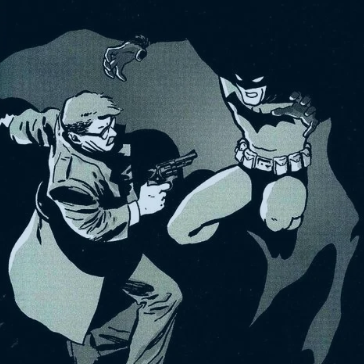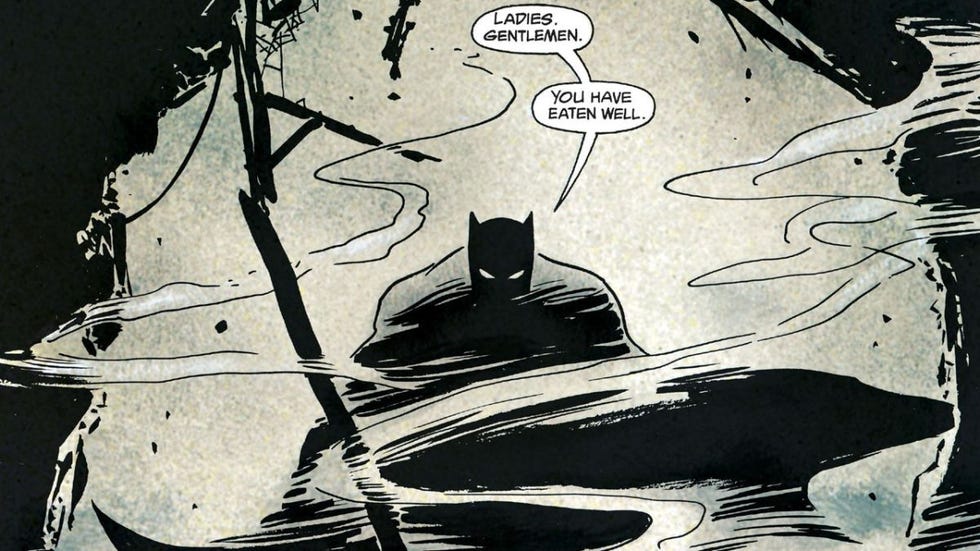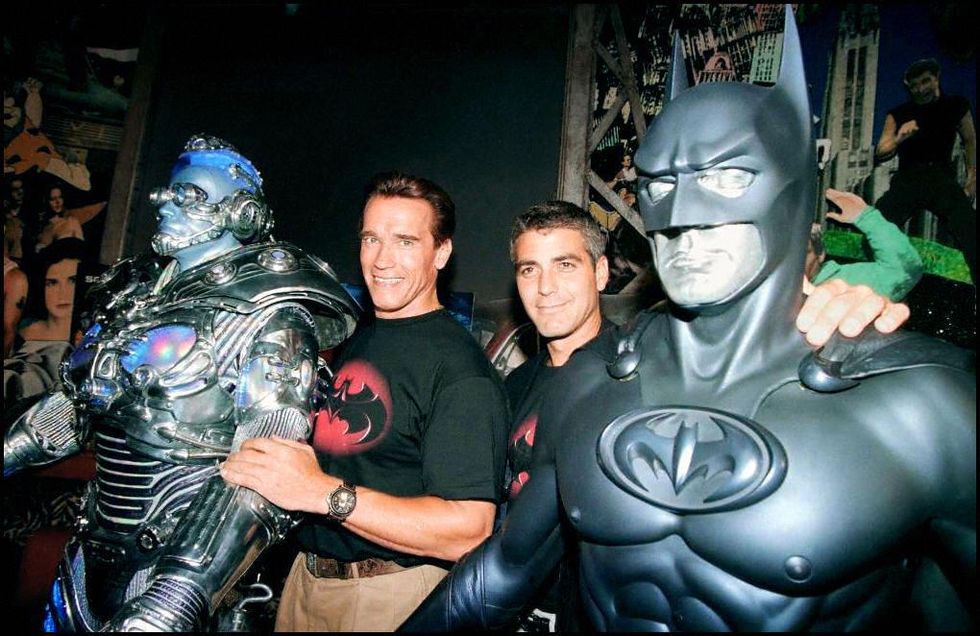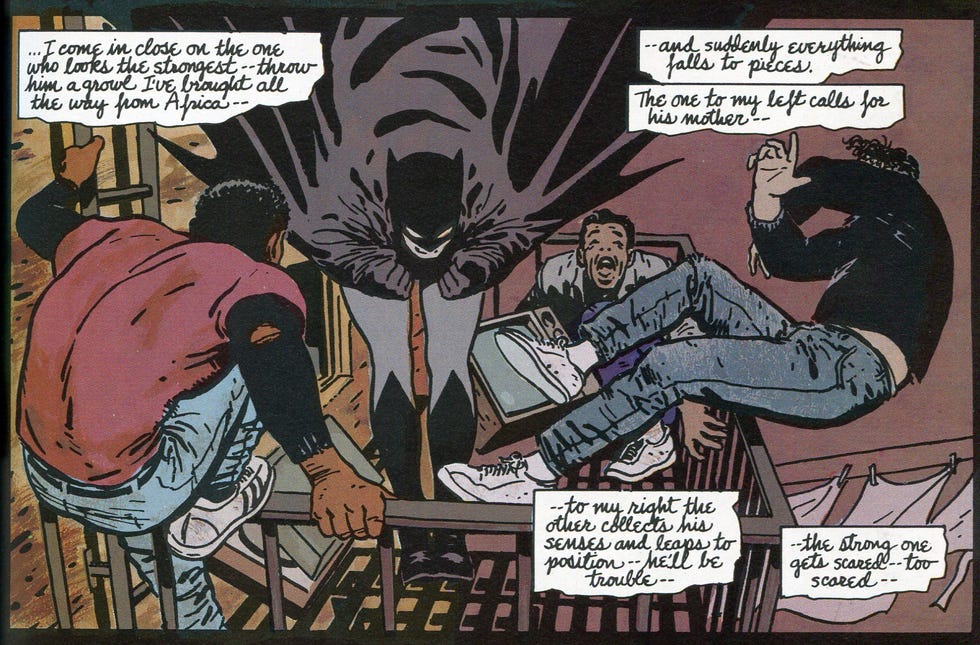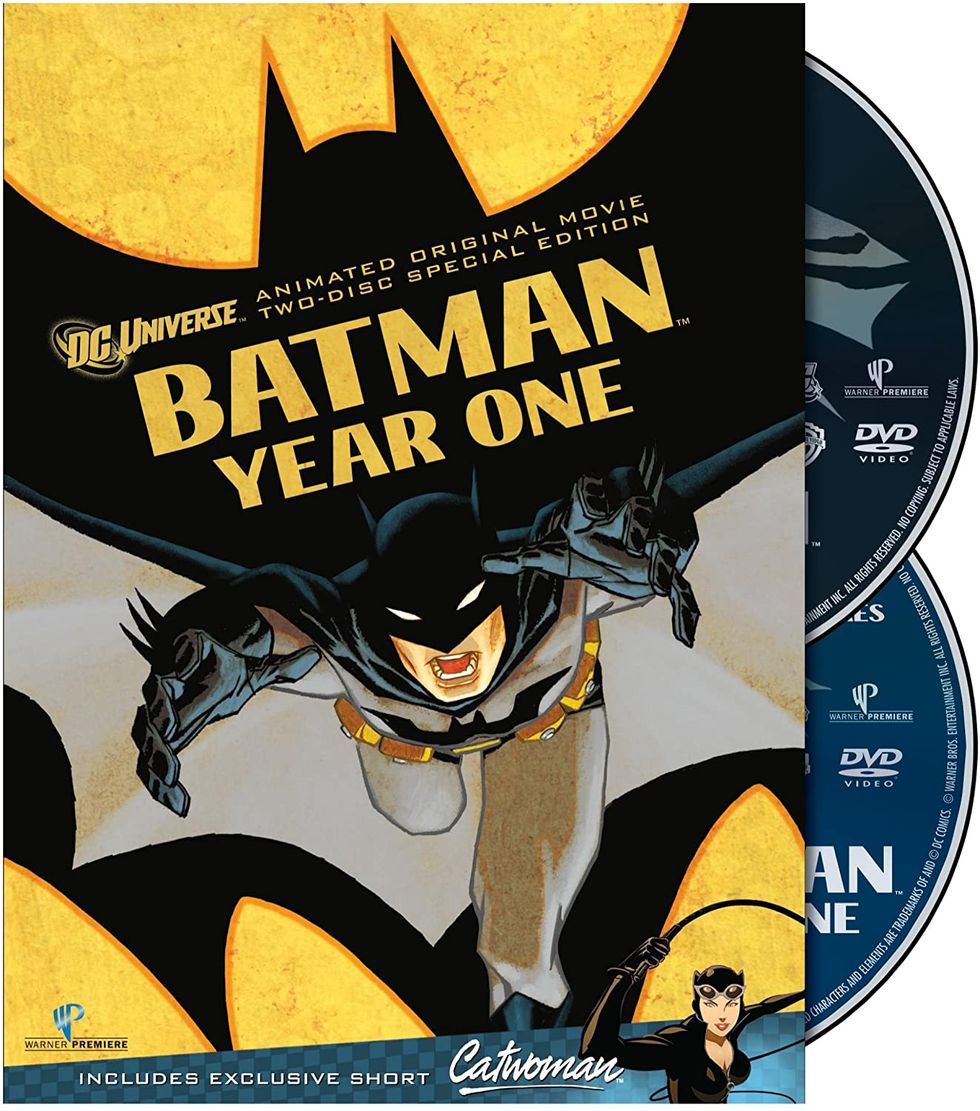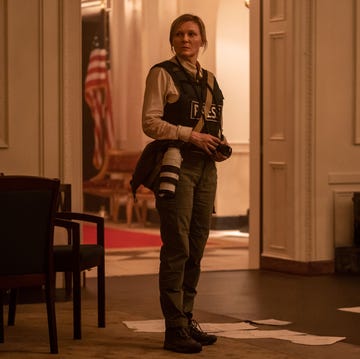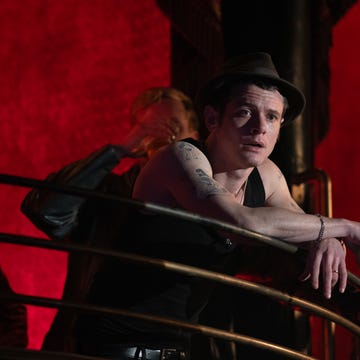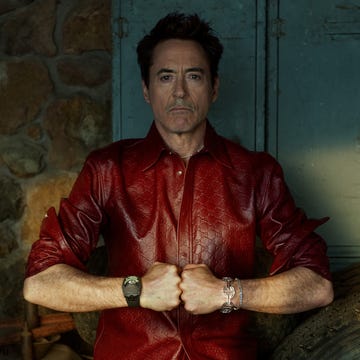In 1987, DC Comics, the publishers of Batman, released a four-issue story arc. Running across issues 404-407 it was titled Batman: Year One. The idea was to retell Batman’s origin story, how a young Bruce Wayne chose to become a crimefighter after seeing his parents gunned down on Gotham’s Crime Alley. It was a tale that had been told many times throughout the character’s 48-year history, sometimes with slight factual tweaks, but always keeping the most salient details intact.
Year One was written by Frank Miller and illustrated by David Mazzucchelli and is today regarded as one of the finest works in comic book history – noted for its unusual noir tone, street-level violence and a more realistic take on how multimillionaire orphan Bruce Wayne chose to put on tights and a cowl and became Batman.
Both Miller and Mazzucchelli have gone on to become revered characters in the comics industry, winning multiple awards and inspirin fanboy devotion. It was Batman: Year One put them on that journey.
Yet Year One was born out of necessity as much as it was artistic vision.
By the end of the Eighties DC Comics had got itself into a pickle. Forty years into its history, the American comics giant was deep into an idea we’re familiar with from the Marvel movies today – the multiverse.
The multiverse supposes that our heroes’ current reality is simply one of many – allowing for multiple timelines and for characters and situations to take place simultaneously in different worlds. Marvel have used the multiverse to box-office slaying effect. A cameo from Daredevil here, a nicely teed-up up spin-off show for The Vision and The Scarlet Witch there. As per 2018’s animated Spider-Man: Across the Spider-Verse and last year’s record-breaking Spider-Man: No Way Home, should those multiverse timelines somehow cross and those separate universes bleed into one another, you’d best be prepared for some unexpected consequences. Plus, total meltdown in the fan forums.
Back in pre-blockbuster 1985 though, DC had tangled itself in knots with its multiple timelines and multiple versions of the same characters. Anyone picking up a copy of Wonder Woman for the first time would have needed a volume of footnotes just to work out who was who and what was what. One issue of The Flash, featuring a story called ‘The Flash of Two Worlds’, found Barry Allen, The Flash from the Sixties, teaming up with Jay Garrick, The Flash from the Forties. What was all that about? It was hard to say.
In an effort to resolve this mess and create one coherent set of rules – and aware that arch-rival Marvel was trouncing them in sales – DC came up with the 12-issue limited series, Crisis on Infinite Earths, which ran from 1985 to 1986 and resolved to tie-up all its main heroes into a single arc, rebooting them in a way newbies and seasoned comics aficionados could all understand. Notable for its high death-count – goodbye Black Bison, Blue Beatle, Cheetah, Fastball or Fiddler, you will not be missed – it was a chance for DC to reboot its entire franchise and start anew. Each standalone comic was relaunched as Issue One.
Frank Miller, the comic book artist and writer, already had form with taking established properties and rebooting them in his own highly-unusual (for comics at least) hard-boiled style. In 1986 he produced two works that still quicken the pulse of comic book enthusiasts today, Daredevil: Born Again, his first collaboration with David Mazzucchelli, that featured the blind Marvel superhero being put through a series of decidedly adult traumas including becoming homeless, being barred from his job practising law and discovering his ex-girlfriend has turned to prostitution. Catholicism formed another running theme – not the kind of topics you’d find troubling The Flash.
Then there was Miller’s masterwork – Batman: The Dark Knight Returns.
Featuring an out-of-shape 55-year-old Batman coming out of retirement to save a Gotham City overrun by corruption and sleaze, it returned the Caped Crusader to a central place in pop culture, its dark and violent tone, plus its visceral, movie-indebted style of storytelling – this time the script and art was all Miller’s – become a huge influence on the multi-billion dollar film franchises that followed. Essentially, it's when Batman "went dark".
(“Hmm, The Dark Knight,” mused Miller, of the title to Christopher Nolan’s 2008 movie, sarcastically. “I wonder where they got that idea?”)
Miller’s Dark Knight Returns contract also called from him to produce a standalone Batman origin story.
At the time sales of the monthly Batman comic were in the doldrums. Mindful of The Crisis on Infinite Earths saga, Miller was given latitude to go to town, and allowed a then-unheard of amount of creative freedom with DC’s leading piece of intellectual property. So what if Batman was a knackered pensioner doing battle in an uber-violent future Gotham? At least someone might buy it.
Miller handled the script and convinced Mazzucchelli to come on board for the art. He kept Bob Kane and Bill Finger’s basic origin story from 1939 – a young Bruce Wayne vows to avenge his parents’ death after seeing them gunned down in Crime Alley – but rather than displaying him as a larger-than-life playboy, he used Year One to show us something different. Wayne becoming the proto-Batman, and a more realistic character, hell-bent on vigilantism. Sure, putting on tights and a cowl to go and beat up muggers is ludicrous – but what if Miller accepted the downsides to that ludicrousness, while still keeping enough comic book action to keep the fans happy?
Miller’s proto-Batman was angry, vulnerable, inexperienced and often ineffective. He gets shot by the police, his opponents outwit and outfight him – most humiliating of all his homemade costume doesn’t fit. The action is street-level and violent. A far cry from Adam West’s Sixties TV series – where the campy fighting was illustrated with a POW! a WHAM! a BIFF! or a WHACK! – in Batman: Year One bones get snapped and noses get busted.
Mazzucchelli’s arresting artwork also served to make Year One look grimy and muted – using flat colour to reflect a dirty Gotham in desperate need of being cleaned up. Compared to the luxe treatment of The Dark Knight Returns, the four-issue run was printed on cheap and throwaway monthly comic book stock – something that actually worked in the story’s favour. (Subsequent ‘deluxe’ editions have drawn their author’s ire – possibly the first time in publishing history that a writer or artist has complained the quality of the paper stock is too good.)
Batman: Year One focuses on billionaire Bruce Wayne returning home to Gotham after 12 years abroad, to begin training for his one-man war on crime. One thing that elevates the storytelling is the significant and parallel focus on James “Jim” Gordon, the cop we’d eventually all know as Commissioner Gordon.
Just as Wayne is finding his feet in an unfamiliar environment, so is Gordon. In Day One he has been transferred from Chicago, his wife Barbara is pregnant and he soon realises the Gotham police department is run through with corruption and dodgy cops.
In an attempt to stop him cleaning up the department, the flawed and human Gordon gets beaten by fellow officers, and his wife is threatened. As Year One progresses – it is told episodically, over 12 months – we see Gordon rise from Detective to Lieutenant to Captain, as his tentative relationship with the naïve vigilante Batman develops.
As Bruce Wayne/ Batman checks out the east end of the City, the most-crime stricken area, he realises that to be effective he needs the criminals to fear him. Hence the Batsuit. We also briefly meet Selina Kyle – a prostitute turned cat burglar – who will become Catwoman. Viewers of Robert Pattinson’s upcoming The Batman movie, will see something similar.
Year One was highly unusual at the time. Darker, more mature, grittier in tone and direction than anything ever seen in the previous years of the Caped Crusader’s stories, the noir-influenced pulp storytelling was a commercial and critical hit. One reviewer suggested the story arc and the relationship between Wayne/ Batman and Gordon shared parallels with the 1973 Al Pacino film Serpico. Along with The Dark Knight Returns and Alan Moore and Dave Gibbons’ Watchmen, also published in 1986, it prompted endless broadsheet articles along the theme of comics “no longer being [just] for kids”. Together these books changed the game. It was a high-water mark that has been endlessly imitated in the four decades since. As any Top 10 list of The Greatest Comics Ever Made will attest – it has yet to be bettered.
One of the great things about the Batman character is that he is endlessly malleable.
You can have Adam West’s knowingly silly version from the Sixties TV series – a memorable scene from the 1966 spin-off movie featured West's Batman hanging from a helicopter while fending off an obviously rubber shark using his “Shark Repellent Bat-Spray”. And you can have Batman Beyond, an animated futuristic version from 2039 with a cyberpunk theme and a cult following. And both are equally valid.
While Miller and Mazzucchelli were busy turning Batman into a hard-boiled Dashiell Hammett character, over in the movie theatres another Batman was doing his thing.
At the same time Batman: Year One hit the newsstands, Tim Burton began filming what would become a new run of Batman films. In Batman (1989), Michael Keaton, then worried about being typecast a comic actor, took up the lead role in the first of two movies. Jack Nicholson signed on as The Joker – after agreeing to an eye-watering $50m salary. It was worth it. The first Batman alone grossed over $400m. It was followed by Batman Returns (1992), Batman Forever (1995, with Val Kilmer) and Batman & Robin (1997, with George Clooney).
By the fourth movie the wheels had started to come off the Batmobile.
Clooney’s Batman is today mostly remembered for fact that for the costume designer had somehow alighted on a Batsuit that featured external nipples. It is packed with a vast and ridiculous supporting cast. Chris O’Donnell is Robin. Arnold Schwarzenegger is Mr Freeze. Uma Thurman is Poison Ivy. Alicia Silverstone is Batgirl. Robert Swenson, an American wrestler, played Bane – the same character in name only later reprised brilliantly by Tom Hardy in the Christopher Nolan films. Even DC now admits the script took a backseat to the opportunities for marketing toys.
A critical and commercial flop, a fifth film in that run was abandoned – Clooney was under contact to do it and a script was written, to be called either Batman Unchained or Batman Triumphant. But the damage to DC’s most important IP was done.
What everyone needed was a reset.
Given the high-water mark being set over in the comics, it was no surprise that Warner Brothers films soon turned to Frank Miller’s interpretation of Batman. A variety of high-profile Hollywood directors apparently pitched in to turn it into a movie, including the Wachowskis, fresh off The Matrix, and Joss Whedon.
Amazingly, Warner Brothers put Miller together with Darren Aronofsky, the then-31-year-old indie director and cineaste, riding high in critical circles thanks to π, the 1998 black-and-white cult mind-bender about a mathematician trying to impose order onto the world, to work up a script together, based on Batman: Year One.
“My pitch was to actually turn Batman into a Seventies film. Sort of Death Wish/ The French Connection meets Batman,” Aronofsky said. “We’re trying to make it work.”
In the script, which you can read in full on the internet, we see a suicidal Jim Gordon sat on the toilet in his boxers late at night, placing his service revolver in his mouth, before his wife calls him to bed, and he thinks better of it. As per the original Thirties comics and the title of Matt Reeves’ 2022’s movie, it may be worth noting that the script lists the Caped Crusader as ‘The Bat-Man’.
In the 2003 book Tales From Development Hell Aronofsky says he told Warners he’d cast Clint Eastwood as his Batman and shoot it in Tokyo, doubling for Gotham City. In contrast to the neon CGI wackiness of Batman & Robin, it would not be sho on sound stages but on real city streets and with ‘real fights’.
“It was the first time I worked on a Batman project with somebody whose vision of Batman was darker than mine,” Miller said. “My Batman was too nice for him! We would argue about it, and I’d say ‘My Batman wouldn’t do that… he wouldn’t torture anybody!’”
The pair's version featured a loner Bruce Wayne who works in a car repair shop. His Batmobile is a Lincoln Continental he's pimped-out by with a pair of bus engines.
‘Heavy, steel modifications have been welded to the chassis,’ according to the script. ‘The hood has been chopped back to make room for the super-charged school bus engine that powers it. And it drives without headlights. Like a car possessed – reckless and demonic’.
“The Nolan films established the Batmobile as a tank, which was a brilliant idea,” Reeves told Esquire in January. “But I thought, ‘Wouldn’t it be cool if this guy is a loner and a gearhead and fashioning these things by himself, taking parts of other cars and kit cars?’ So it’s recognisable as a car this time. But it’s like a muscle car. One that he’s made himself.”
Miller’s Batsuit is home-made, featuring a halved hockey mask as a mask. A makeshift Batcave is established in a subway tunnel.
In The Batman, Reeves shows the Batcave as part of an underground rail network, beneath Gotham.
When Bruce Wayne/Batman first goes looking for criminals in Batman: Year One, there is one frame in which Reeves noted that “he’s dressed in what I thought looked like an image out of Taxi Driver”.
Some of Frank Miller’s notes to David Mazzucchelli are included at the back of a commemorative edition of Year One, published a few years ago. Of that same frame, Miller writes he wanted Batman “to basically look like he’s won a Taxi Driver-lookalike competition”.
Reeves laughed out loud when he read that. They were literally on the same page.
Meanwhile the Miller/ Aronofsky Batman wears a heavy silver signet ring intertwined with the initials ‘TW’, arranged in such a way their leave a bat-shaped scar on anyone he hits.
You may not be surprised to learn that Warners passed on their script. Movie Batman lay dormant for almost two decades, until Christopher Nolan rebooted the franchise in 2005, taking elements of Miller’s comics but adding in enough blockbuster thrills to make his movies thrilling to a popcorn crowd. Christian Bale proved an excellent Batman. His three movies Batman Begins (2005), The Dark Knight (2008) and The Dark Knight Rises (2012) were huge, and hugely deserved, hits.
Promoting his 2017 film Mother! Aronofsky was asked again about his Batman pitch.
“I think we were basically 15 years too early. Because I hear the way they’re talking about the Joker movie, and that’s exactly my pitch.”
Aside from Clint Eastwood, Aronofsky had actually made a suggestion for one other actor to play his Batman … Joaquin Phoenix, who of course won an Oscar for playing The Joker in the 2019 movie, a film that wears its debt to Taxi Driver and Seventies cinema on its sleeve.
As much as Batman: Year One and The Dark Knight Returns continue to exert their stylist influence over Batman all these years later, the movie of that first, ground-breaking and dial-resetting four-issue comic book never saw the light of day.
Except it sort of did.
In 2011 Warner released Batman: Year One, a standalone animated movie, that took Miller and Mazzucchelli’s work, and transposed it into a 64-minute movie.
“Batman: Year One is a stellar adaptation, copying Miller’s words and Mazzucchelli’s images almost verbatim at times,” concluded one critic. “It all recalls what it felt like to read Batman: Year One for the first time, and sense that this was a story that had always existed.”
The movie was a small but significant hit, making $6.1m at the box office off a budget of $3.5m.
Voicing the character of Lieutenant James Gordon was Bryan "Breaking Bad" Cranston. Not quite Clint "Dirty Harry" Eastwood. But, you’ve got to say, not far off either.
‘The Batman’ is in cinemas 4 March
